AQA GCSE Biology Trilogy: Hormones in Human Reproduction
Key Points:
Human sexual characteristics are all controlled by hormones. During puberty, hormones are produced for the first time, causing the development of secondary sexual characteristics, such as the growth of body hair and the deepening of the voice. \n \n The main sex hormone in females is oestrogen whilst in males it is testosterone. Oestrogen and progesterone play a role in maintaining the lining of the uterus during the menstrual cycle, which repeats every approximately 28 days. In addition, FSH and LH stimulate the maturation and release of an egg from the ovary. \n \n Human fertility can be controlled through the use of contraception. Methods of contraception include using artificial hormones to prevent the maturation or release of an egg, or the use of barrier methods to prevent sperm from coming into contact with an egg. Surgical cutting methods can also be used, restricting the movement of the egg to the uterus or sperm from the testicles. Hormones can also be used in IVF to treat infertility if a woman is struggling to conceive, and can be controlled by negative feedback, and mechanisms in the body in normal day-to-day life.
Hormones:
Glands:

Menstruation Hormones:
| Hormone | Produced | Role |
|---|---|---|
| FSH (follicle-stimulating hormone) | Pituitary gland | Causes an egg to mature in an ovary. Stimulates the ovaries to release oestrogen |
| Oestrogen | Ovaries | Stops FSH being produced (so that only one egg matures in a cycle). Repairs, thickens and maintains the uterus lining. Stimulates the pituitary gland to release LH. |
| LH (luteinising hormone) | Pituitary gland | Triggers ovulation (the release of a mature egg) |
| Progesterone | Ovaries | Maintains the lining of the uterus during the middle part of the menstrual cycle and during pregnancy. If a woman becomes pregnant, the placenta produces progesterone. This maintains the lining of the uterus during pregnancy and means that menstruation does not happen. |

Hormones to Treat Infertility:
Fertility Treatments -
Some women have difficulty becoming pregnant because they don't produce enough FSH to allow their eggs to mature. Fertility drugs contain FSH and LH, which stimulate eggs to mature in the ovary. Fertility treatments increase a woman's chance of becoming pregnant, although the treatment may not always work. On the other hand, because the treatment boosts the production of mature eggs, it increases the chance of twins or triplets. Multiple pregnancies carry a risk of complications and may lead to premature or underweight babies.
In Vitro Fertilisation (IVF) treatment -
If a couple are having difficulty conceiving a child because there are issues with the quality of the man's sperm or a woman has blocked oviducts, then IVF can be used. IVF involves giving a mother FSH and LH to stimulate the maturation of several eggs. The eggs are collected from the mother and fertilised by sperm from the father in a dish in the laboratory. The fertilised eggs develop into embryos. At the stage when they are tiny balls of cells one or two embryos are inserted into the mother's uterus (womb). The development of microscopy techniques has allowed IVF treatments to be developed further.

The NHS has to choose which couples they can fund for IVF. If they cannot be treated on the NHS, some people chose to pay privately for treatment. This is very expensive and costs approximately £5000. The chances of a successful pregnancy vary depending on the age of the woman involved. As a woman's age increases, the chance of conception decreases.
| + | - |
|---|---|
| It allows people to have babies of their own, who otherwise can't due to a variety of reasons. | There are side effects from the drugs used, such as hot flushes and severe headaches. |
| It has a safe track record and has been used since 1978. The embryos can be screened for genetic diseases, which is important for families that already have an affected child. Only unaffected embryos are used. | There is a possibility of multiple births, which is dangerous for the mother and babies. |
| Unused eggs can be used for research or donated to other couples. | Ovarian hyper-stimulation syndrome (OHS) can occur (when too many eggs develop in the ovaries) |
| It is very emotionally and physically stressful. | |
| The success rates are not high. |
Some people worry about the ethical implications of IVF. They are concerned that couples may want 'designer babies' with 'desirable' qualities, so may only want certain fertilised eggs. For example, they may want a girl if they have lots of boys in the family. Also, the embryos that are not used may be destroyed. Some people consider embryos to be new lives and view their destruction as unethical.
Contraception:
Oral Contraceptives:
Human fertility is controlled by hormones, so fertility can be controlled using hormonal forms of contraception. The oral contraceptive, which is known as ‘the pill’, contains oestrogen or progesterone. These hormones inhibit the production of FSH, and eggs cannot mature. Contraceptive injections, implants or skin patches contain slow-release progesterone to inhibit the maturation and release of eggs.
| + | - |
|---|---|
| Oral contraceptives are more than 99% effective if taken correctly and can reduce the risk of certain cancers. | There are possible side effects, such as changes in weight, mood and blood pressure due to high levels of oestrogen. Modern pills contain much less oestrogen. |
Non-Hormonal Contraceptive Methods:
Fertility can be controlled without hormones. These methods include -
- Physical barrier methods such as condoms and diaphragms, which prevent the sperm from reaching an egg
- Intrauterine devices (IUD) also known as a ‘coil’, prevent the implantation of an embryo or release of a hormone
- Spermicidal agents which kill or disable sperm
- Abstaining from intercourse when an egg may be in the oviduct, which is called ‘abstinence’
- Surgical methods of male and female sterilisation. An example is a vasectomy, where the sperm ducts are cut and tied.
| + | - |
|---|---|
| Condoms are quick and easy to use and can protect you from STI’s as a physical barrier method. | Condoms can rip or tear. Also, the latex can expire. Some people can be allergic to latex. |
| Diaphragms can protect you from STI’s as a physical barrier method. | Diaphragms need to be put in just before sex and left in several hours afterwards. |
| IUD’s can remain in position for up to 10 years. | IUD’s need to be fitted by a health professional. There is a small risk of causing an ectopic pregnancy. |
| Spermicidal agents can be added to other physical barriers such as condoms, and kill or disable sperm to prevent impregnation. | Some people can have allergic reactions to some spermicides. |
| Abstinence does not cost anything and can be done by the individual. | If the timings are not accurate the chance of pregnancy is high. |
| Surgical methods are incredibly reliable. | Surgical methods cannot be reversed and are considered permanent. |